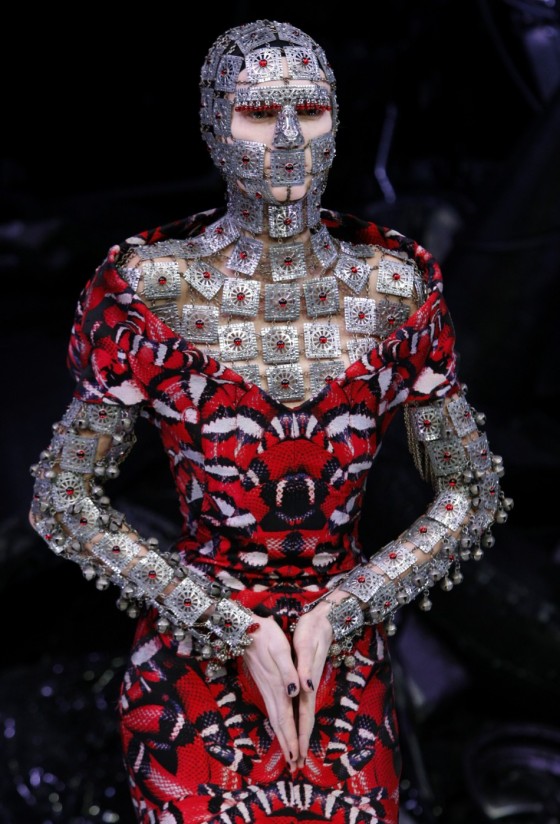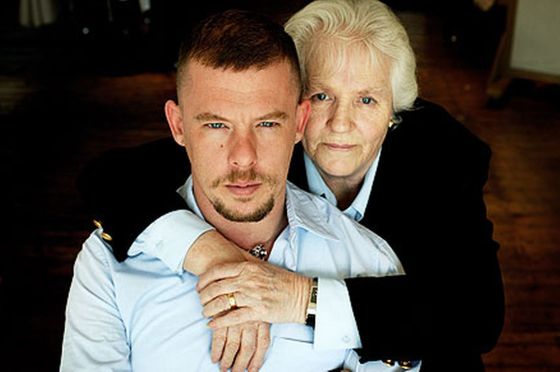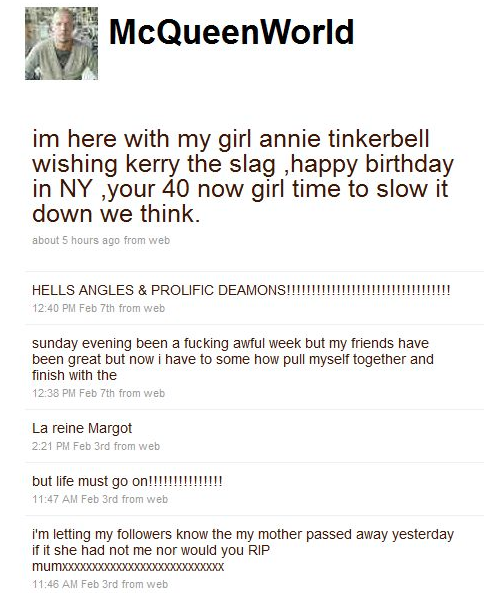Over five years ago, Lee Alexander McQueen committed his most selfish act, taking his own life. After the fatal death of his mother Joyce, and the suicide of his mentor Isabella Blow, McQueen hung himself in his Mayfair apartment. This of course won’t be news to any of you – but with the recent ‘Savage Beauty’ exhibition coming to V&A in London, and Bath Fashion Week giving an hour talk on Lee’s life, I decided to indulge deeper into what lead to McQueen’s ill – fated destiny.
Lee Alexander McQueen was born on March 17, 1969 in Lewisham, London. His father, Ronald, was a taxi driver in East London, and his mother, Joyce was a teacher who taught social science. On their small incomes, they supported McQueen and his five siblings. At the age of 16, McQueen dropped out of school and found work on Savile Row at a tailor shop ‘Anderson and Shephard’, and then moved to the bespoke ‘Gieves and Hawkes’. After realising his metier, McQueen decided to start working with theatrical costume designers Angels and Bermans; the dramatic style of clothing he made there would later become a signature of his later independent design work.
McQueen then left London for a short stint in Milan, where he worked as a design assistant to Italian fashion designer Romeo Gigli. Upon his return to London, he enrolled at Central Saint Martin’s College of Art & Design, and received his M.A. in fashion design in 1992. The collection he produced as the culminating project of his degree was inspired by Jack the Ripper, and was famously bought in its entirety by the well-known London stylist and eccentric Isabella Blow. She became a long-time friend of McQueen, as well as an advocate for his work.
Soon after obtaining his degree, Alexander McQueen started his own business designing women’s clothes to which he met enormous success – especially with the introduction of his “bumster” trousers (named because of their extremely low – cut waistline).
Only four years out of design school, McQueen was named Chief Designer of Louis Vuitton-owned Givenchy, a French haute couture fashion house. Although it was a prestigious job, McQueen took it reluctantly, and his tenure there (from 1996 to 2001) was a tumultuous time in the designer’s life. Even as he was pushing the limits of what people expected from fashion (one of his shows featured a model who was an amputee walking the runway on carved wooden legs), McQueen felt he was being held back. He would later say that the job “constrain(ed) his creativity.” However, he also made the following admission: “I treated Givenchy badly. It was just money to me. But there was nothing I could do: the only way it would have worked would have been if they had allowed me to change the whole concept of the house, to give it a new identity, and they never wanted me to do that.” Even with his reservations about his work, McQueen won British Designer of the year in 1996, 1997, and 2001, all during his time at Givenchy.

McQueen tested the boundaries by sending amputee model Aimee Mullins down the catwalk with carved wooden legs
In 2000, Gucci bought a 51 percent stake in Alexander McQueen’s private company, and provided the capital for McQueen to expand his business. McQueen left Givenchy shortly thereafter. In 2003, McQueen was declared International Designer of the Year by the Council of Fashion Designers of America and A Most Excellent Commander of the British Empire by the Queen of England, and won yet another British Designer of the Year honor. Meanwhile, McQueen opened stores in New York, Milan, London, Las Vegas and Los Angeles. With the help of Gucci’s investment, McQueen had become even more successful than he was before. Already known for the flare and passion of his shows, McQueen produced even more interesting spectacles after leaving Givenchy. Most notably, a hologram of model Kate Moss floated ethereally at the showing of his 2006 Fall/Winter line.
Alexander McQueen was also known for not being shy about his lack of traditional good looks or his lower class background. One acquaintance described that during a first encounter, McQueen was “wearing a lumberjack shirt with the most low-class kind of schlubby-looking jeans falling down with a long key chain…[and was] quite podgy.” Another friend said that his teeth “looked like Stonehenge.” According to those who knew him closely, McQueen was proud of breaking the traditional mold of a successful designer.
In 2007, the specter of death would come to haunt McQueen, first with the suicide of Isabella Blow. The designer dedicated his 2008 Spring/Summer line to Blow, and said that her death “was the most valuable thing I learnt in fashion.” Just two years later, on February 2, 2010, McQueen’s mother died. One day before her funeral, on February 11, 2010, McQueen was found dead in his Mayfair, London apartment. The cause of death was determined to be suicide.
Lee was found hung in his wardrobe (which is quite symbolic considering his legacy in fashion) and was said to have slashed wrists. The autopsy stated that McQueen had a “lethal cocktail of cocaine and prescription drugs” in his body at the time of death. Notably plagued and struggling with depression, anxiety and insomnia, it was still a surprise to find the designer dead in his Mayfair apartment close sources reveal.
Most notably, the tweets sent from Lee’s personal account showed little sign of remorse or no hint of what was still to come:
Read Bottom to Top
However, the designer had made previous suicide attempts, and when the death of his mother had finally sunk in, McQueen had lost the one thing he felt was worth living for. Most fatally, the police found knives around the room, one which he used to previously cut himself, and his laptop open to information on how to commit suicide.
The toxicology report showed his blood contained 2.8 milligrams of cocaine per litre – enough consummation to kill him, without the need of the noose or the slashed wrists. As little as 0.7mg per litre can prove fatal.
A suicide note was found, scrawled on the back of a book called “The Descent of Man” (again, symbolic) and read: ‘Look after my dogs. Sorry, I love you, Lee. P.S. Bury me at the church.’
Alexander McQueen’s rise from lower-class high school dropout to internationally famous designer is a remarkable story. His bold styles and fascinating shows inspired and wowed the world of fashion, and his legacy lives on. However, there is something more striking about McQueen’s story than perhaps any other suicide or death in the industry. There is something very symbolic in Lee’s story which resonates in the fashion world and the memories of his fans and family today.
McQueen’s story was characterised by loneliness and controversy. With a portfolio of memorable shows/looks such as the ‘Golden Showers’ of 1998 which saw the models walking down the runway, caught in a storm, clothes soaked and makeup running. Or the iconic Plato’s Atlantic for it’s unearthly beauty, and the poignant promise of what’s yet to come. It was, of course, his last show.
Looking through the blurred lines of depression and anxiety, McQueens legacy was an individual self – professed mission to change and challenge the boundaries of an industry which inevitably lead to his own self – destruction. McQueen was reported to have said that when he was happy, his collections suffered and the intensity of his frustrations would be reserved and not taken out on his collections. His life and his death were both the same tragic tale, and one was inextricably linked with the other. The symbolic references of McQueen’s suicide (the book, the knives, the cocaine, the tweets, the hanging in the wardrobe) all makes his legacy that much more cataclysmic.
The point of this blog was both to give tribute to McQueen’s fashion endowment, and to ensure that the British population don’t forget that it was he who demolished the rules of fashion and broke tradition. It’s safe to say that those active during McQueen’s reign of British fashion were lucky enough to witness the revolution, and those younger, should learn about him as a fashion hero, and an irrevocable artist.
Never forget the importance of a healthy mental state. I can’t help but think that the tragic death of McQueen has unearthed a perversive impact on British fashion since 2010. An evolution of couture was storming, brewed to be exposed and unveiled by the legend Alexander McQueen himself.
My Not So Fair Lady xox
Unfortunately, I can’t attend the McQueen talk for part of Bath Fashion Week, so if you can – make sure you get tickets: http://bathinfashion.co.uk/event/alexander-mcqueen-savage-beauty/
Also, keep checking back to the V&A website and book tickets for the McQueen Savage Beauty exhibition (not to be missed!): http://www.vam.ac.uk/content/exhibitions/exhibition-alexander-mcqueen-savage-beauty/







